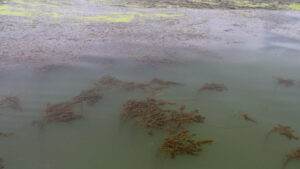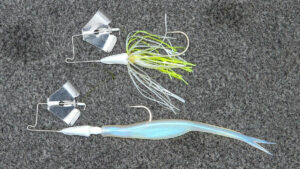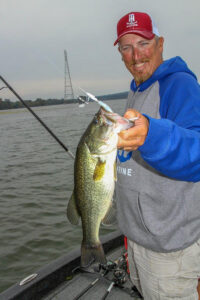As we progress into fall, most lakes will see their grass beds shrinking and scattering as they break apart in colder waters. This can be the prime time to hone in on big bass on shrinking feeding areas of breaking grass.
Amid the flipping and frogging that’ll remain in play as long as some level of grass density remains, Alabama pro Jimmy Mason nabs loads of big bass by focusing on these ragged edges.
“On a grass lake, matted vegetation is where the bass flock to in the fall,†Mason said. “That’s where the baitfish go and the bass follow.
“As the fall progresses and those mats break up, you get a lot of stringy grass out from the main body of the mat.â€
Bassmaster Elite pro Greg Hackney likes the tattered fall look because it creates more contour features like points, breaks and the isolated clumps that are always worth a cast or two.
“The fish are hard to target in the fall when they don’t set up on anything; when they’re just running around chasing shad,†Hackney said. “But when they set up on that grass, you can figure out a target, right where that fish is sitting.â€
And, as Hackney points out, bass that have been passing the dog days deep within a mat’s densest and nearly inaccessible reaches will move to the edges with one thing on their minds.
“These fish that set up on the outside edges of the grass are there to eat,†Hackney said. “They’re sitting there in an aggressive posture looking outward and waiting to ambush something as it comes by.â€
THE DAILY BUZZ
Indeed, with fall’s cooling weather comes a spike in feeding, as bass preparing for winter relentlessly harass shad along those tattered grass mat edges. Making noise and garnering attention is Mason’s mission, so he’s all-in for the buzzbait.
“If the weather’s stable, I’m going to throw a standard 1/4-ounce or 1/2-ounce buzzbait, but if it gets tough on the backside of these fall cold fronts, then I’ll downsize to a 1/8-ounce buzzbait,†he said.
“You really don’t eliminate the bigger fish by going to a smaller bait. A lot of times, you’ll catch the biggest fish of the fall this way.â€
Mason likes the Booyah Pond Magic buzzbait, a model that packs a solid hook into a scaled-down profile. This look fits the seasonal forage profile.
“The shad are smaller in the fall — they’re the ones that were hatched earlier in the year,†Mason said. “When they’re schooling around these mats, this smaller buzzbait really imitates what the bass are eating.
Favoring the chartreuse/white pattern, Mason throws his bait on a 7 1/2-foot Lew’s Magnum 3 spinning rod with 15-pound Vicious braided line.
“That allows me to launch the bait a long way and cover a lot of water,†he said. “I like braided line because when I get a big fish in the grass, I’m able to horse him out.â€
PROBLEM SOLVING
When conditions are nice and the fish are “on,†engulfing bites ensure solid hookups. However, Mason said fall often balances the bounty with frustration — from weather and from the fish.
Not to worry, though; a simple adjustment keeps him in the game.
“If it’s windy, or if the fish are finicky, I’ll remove the buzzbait’s skirt and replace it with a YUM Breaking Shad, a 4 1/2-inch soft jerkbait,†he said. “By taking off that skirt, you lose a lot of wind resistance and you’re able to make extremely long casts.
“When the fish are coming up and boiling on your buzzbait or missing it, this gives the bait a different look and allows you to catch a lot of those fish that you were missing before.â€
DROP IT TO ‘EM
Hackney said he’ll take a few shots with a spinnerbait and Strike King Pure Poison swim jig — especially if he sees fish breaking on a mat’s outer edge. But he’s a flipper at heart, so short presentations to those likely setup points in the mat’s perimeter are his preference.
Texas-rigged plastics will tempt plenty of fall bass, but Hackney fits his signature series 1-ounce Hack Attack Jig with a Strike King Rage Craw trailer for a profile more likely to impress the big fish. A heavy bait zipping past an aggressive, appetite-driven fish usually meets with violent response.
Hack describes a fall grass bite as a serious pulse-pumper: “Usually, when we’re fishing in grass we’re feeling for pressure or little line twitches; but these fish will hit your bait with a hammer.â€
You’ll find fish of all sizes along a mat’s tattered edges, but that’s why Hackney prefers the jig over the more quantity-focused Texas-rigged plastics. The profile of a full-sized flipping jig tends to weed out the whipper snappers, while enticing the quality fish.
“You won’t get as many bites on a jig, but the ones you get will be good ones.”
















